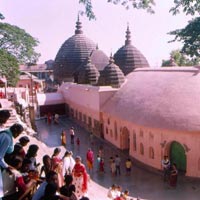|
Day 1: Guwahati ,Umananda Temple,Shakardev Kalakhetra,Basistha Ashram:,
Kamakhya temple is a famous pilgrimage situated at Guwahati, Assam. The temple is located on the Nilachal hill in Guwahati at about 8 kms from the railway station. The Kamakhya temple is dedicated to the tantric goddesses. Apart from the deity Kamakhya Devi, compound of the temple houses 10 other avatars of Kali namely Dhumavati, Matangi, Bagola, Tara, Kamala, Bhairavi, Chinnamasta, Bhuvaneshwari and Tripuara Sundari.,Mythical
History:
The temple of Kamakhya has a very interesting story of its origin. It is one of the 108 Shakti peeths. The story of the Shakti peeths goes like this пешеходные маршруты Сочи; once Sati fought with her husband Shiva to attend her father's great yagna. At the grand yagna, Sati's father Daksha insulted her husband. Sati was angered and in her shame, she jumped into the fire and killed herself. When Shiva came to know that his beloved wife had committed suicide, he went insane with rage. He placed Sati's dead body on his shoulders and did the tandav or dance of destruction. Kamakhya Temple To calm him down, Vishnu cut the dead body with his chakra. The 108 places where Sati's body parts fell are called Shakti peeths. Kamakhya temple is special because Sati's womb and vagina fell here.
UMANANDA TEMPLE:
The Umananda temple is located on a small island on the Brahmaputra river. The island is called Peacock Island and perhaps is the smallest river island in the world. To visit this place you will need to take a ferry ride from the banks. There is a small hill on the island sheltering the temple namely, Bhasmacala.
Lord Shiva is said to have resided here in the avataar of Bhayananda. As per the legend goes according to an ancient purana, Kalika Purana, in the very beginning of the creation Shiva imparted knowledge to his wife Parvati on this hill and meditated here. It says that, when Lord Shiva was in meditation on this hillock. It is said that Kamadeva interrupted his yoga and was therefore burnt to ashes by the fire of Shiva’s anger and hence the hillock got the name Bhasmacala.
SHAKARDEV KALAKHETRA:
Timings
All days of the week
10:00 AM - 7:30 PM
Srimanta Shankardev Kalakshetra is a premier institution exhibiting the culture and heritage of Assam. Spread over a vast amplitude, the complex houses different buildings that are systematically arranged according to art, dance, sculptures etc. The diverse ethnic groups and subgroups who have created the cultural mosaic which is the essence of the State, are displayed in all their beauty and splendour.
Named after the great unifier and the creator of modern Assamese community, Srimanta Shankardev this cultural institution will introduce you to what Assam is all about. The displays and the visuals of the place is so vast that it can barely be explained in words. It is better experienced than being told about.
BASISTHA ASHRAM:
Basistha (Pron: bəˈsɪsθə) temple, located in the south-east corner of Guwahati city is a Shiva mandir constructed by Ahom King Rajeswar Singha in 1764[1] along with gift of land 835 Bighas for the ashram. The history of the Basistha Ashram where the temple is located dates back to the Vedic age. According to legend the ashram was founded by the great saint Basistha (Vasishtha).
Temple in the ashram stands on the bank of the mountain streams originating from the hills of Meghalaya, which becomes the rivers Basistha and Bahini/Bharalu flowing through the city.
This ashram is believed to be the home of famous sage Basistha, also known as "Vasishtha". The ashram is located a few kilometers (10-12) from Guwahati, on the outskirts of Garbhanga reserve forest which has an ample population of Elephants. This Garbhanga reserve forest is also a proposed Butterfly reserve. Although the ashram has a temple but still the cave in which the Muni Vasistha is believed to have meditated is located 5 K.m. inside the ashram. The ashram also has a waterfall.
|

